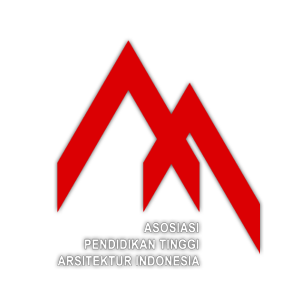Space Syntax Analysis on Edu-Tourism Accessibility (Case Study: Planetarium UIN Walisongo Area)
Alifiano Rezka Adi(1*), Selamet Riyadi(2)(1) Islamic Art and Architecture Program, Faculty of Usuluddin and Humanities, State Islamic University of Walisongo Semarang
(2) Islamic Art and Architecture Program, Faculty of Usuluddin and Humanities, State Islamic University of Walisongo Semarang
(*) Corresponding Author
Abstract
Planetarium UIN Walisongo is an educational facility that not only accommodates academic needs but is also projected to become a tourism destination in Semarang. The density of activity is the main focus that must be considered. The building's existence in the middle of the campus also demands that it has good visual access. The study focused on configuration and visibility analysis by looking at their effect on accessibility around the building. The research was conducted using quantitative methods with a descriptive and simulation framework. The simulation process is carried out using a space syntax approach with Depthmap software. Macroanalysis shows that the building is located in the central area with a relatively high integration value. The high intelligence value shows that the spatial configuration is relatively easy to recognize. The wide and integrated road makes this area have relatively high visibility. Microanalysis shows that the pedestrian around the Planetarium is not well connected. Space engineering by connecting pedestrians is carried out to provide better accessibility. Achievement efficiency is the main consideration to produce a high value of integration and visibility around the building. Therefore, the area quality will be better with an accessible space on macro and micro scales
Keywords
Full Text:
PDFReferences
Andi, Zain, Z., & Fery Andi, U. (2021). Pengaruh Konfigurasi Ruang terhadap Jumlah Pengunjung pada Bangunan Komersial Mal di Pontianak. Jurnal Space, 8(1), 45–60.
Bafna, S. (2003). Space Syntax: A Brief Introduction to Its Logic and Analytical Techniques. Environment and Behavior, 35(1), 17–29. https://doi.org/10.1177/0013916502238863
Behbahani, P. A., Gu, N., & Ost-Wald, M. J. (2014). Comparing the Properties of Different Space Syntax Techniques for Analysing Interiors. 48th International Conference of the Architectural Science Association, 683–694.
Ching, F. D. K. (2007). Architecture - Form, Space and Order 3rd Edition. Erlangga.
Firdausi, F. S. (2017). Architecture Based on the Change of Acticity and Time. Department of Architecture, Institut Teknologi Sepuluh November.
Hidayati, I., & Rifani, I. (2021). Mewujudkan Kota Ramah Pejalan Kaki: Kasus Kota Yogyakarta. Jurnal Pendidikan Dan Penelitian Geografi, 2(1), 85–91. http://ejurnal.unima.ac.id/index.php/geographia
Hillier, B. (2007). Space is the Machine. Space Syntax.
Karimi, K. (2012). A Configurational Approach to Analytical Urban Design: Space Syntax Methodology. Urban Design International, 17(4), 297–318. https://doi.org/10.1057/udi.2012.19
Nurhasan, Purwono, E. H., & Haripradianto, T. (2015). Perancangan Planetarium di UIN Walisongo Semarang. Jurnal Mahasiswa UB, 3(4).
Permana, A. Y., Permana, A. F. S., & Andriyana, D. (2020). Konfigurasi Ruang Berdasarkan Kualitas Konektivitas Ruangan Dalam Perancangan Kantor: Space Syntax Analysis. Jurnal Arsitektur ZONASI, 3(2), 155–170. https://doi.org/10.17509/jaz.v3i2.25893
Puspitasari, C. (2020). Metode Analisis Space Syntax Pada Penelitian Interaksi Kota Multibudaya. Jurnal Arsitektur Lakar, 3(1), 36–44.
Romdhoni, M. F., Priemadella, & Fitriawijaya, A. (2018). Analisa Pola Konfigurasi Ruang Terbuka Kota dengan Penggunaan Metoda Space Syntax sebagai Spatial Logic dan Space Use. NALARs, 17(2), 113–128. https://doi.org/10.24853/nalars.17.2.113-128
Sa’diyah, A. H., Nugroho, R., & Purwani, O. (2019). Space Syntax Sebagai Metode Perancangan Ruang Pada Galeri Kreatif di Kota Surakarta. Jurnal Senthong, 807–816.
Sherlia, S., Jordan, N. A., & Syafitri, E. D. (2021). Space Syntax Analyses in Defining the Connection of Development Centers in Balikpapan. DIMENSI (Journal of Architecture and Built Environment), 48(1), 1–8. https://doi.org/10.9744/dimensi.48.1.1-8
Sholahuddin, M. (2007). Setting Ruang dan Pengaruhnya Terhadap Aksesibilitas Para Penyandang Cacat Tubuh di Pusat Rehabilitasi Yakkum Yogyakarta. Jurnal Lintas Ruang, 1(1), 31–41.
Siregar, J. P. (2014). Metodologi dasar space syntax dalam analisis konfigurasi ruang. Jurusan Perencanaan Wilayah dan Kota, Fakultas Teknik, Universitas Brawijaya.
Turner, A., Doxa, M., O’Sullivan, D., & Penn, A. (2001). From Isovists to Visibility Graphs: A Methodology for the Analysis of Architectural Space. Environment and Planning B: Planning and Design, 28(1), 103–121. https://doi.org/10.1068/b2684
Turner, A., & Penn, A. (1999). Making Isovists Syntactic: Isovist Integration Analysis. 2nd International Symposium on Space Syntax. https://www.researchgate.net/publication/242075155
Ulvianti, F., & Anindita, A. (2018). Integrasi dan Konektivitas Ruang Terbuka Publik di Kampung Kota (Analisis Space Syntax di Kawasan Pasar Simpang Dago). D020–D026. https://doi.org/10.32315/ti.7.d020
Yudhanta, W. C. (2018). Pengaruh Konfigurasi dan Visibilitas Ruang Pada Aksesibilitas - Studi Kasus pada Kawasan XT Square Yogyakarta. Jurnal Arsitektur Komposisi, 12(1), 67–76.
Article Metrics
Abstract view(s): 612 time(s)PDF: 616 time(s)
Refbacks
- There are currently no refbacks.









